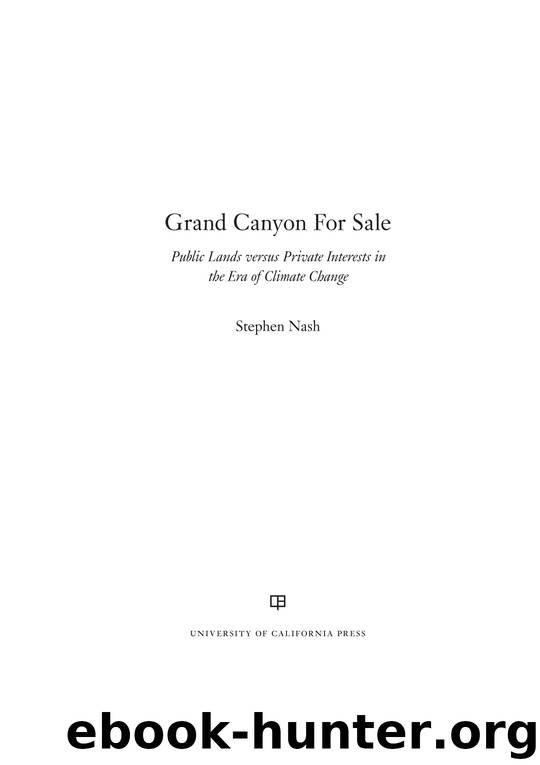Grand Canyon for Sale: Public Lands Versus Private Interests in the Era of Climate Change by Stephen Nash

Author:Stephen Nash [Nash, Stephen]
Language: eng
Format: epub
Tags: science, Natural History
ISBN: 9780520291478
Google: woMlDwAAQBAJ
Amazon: 0520291476
Publisher: Univ of California Press
Published: 2017-09-05T00:00:00+00:00
Not long ago, evincing concern about climate change and other environmental threats, the BLM convened a group of federal scientists to develop a national “Rapid Ecoregional Assessments” technique, “to more fully understand ecological conditions and trends; natural and human influences; and opportunities for resource conservation, restoration, and development.” The project was funded at $40 million. The participating scientists were told by BLM officials to consider the impacts of “change agents” and evaluate them.
Then they were instructed that grazing was not going to be included among the “change agents” and was not to be part of the study. If that hints at light farce, the agency’s defense when challenged enlarges the mood. After decades of assurances that it has been monitoring its lands to keep them healthy, carefully gathering data and stewardshipping, the BLM now demurred modestly. Its data on grazing and land health conditions are neither complete enough nor reliable enough to be included in its “ecoregional assessments,” it decided. No curiosity was evident, either, about the substantial pile of research available from other sources about grazing as a “change agent.”
The minutes of planning sessions for the assessment program show protests from some of the scientists present. “We will be laughed out of the room if we don’t use grazing,” U.S. Geological Survey ecologist Tom Edwards—a peer reviewer for the assessment—told the group. “If you have the other range of disturbances, you have to include grazing.”
That was prescient. The ensuing uproar included a formal challenge to the BLM’s scientific integrity by a public employees’ environmental group. The agency investigated itself and found nothing amiss. Just the same, after producing six ecoregional assessments that put the hush on grazing impacts, it reversed course and included this “change agent” after all, in the seventh region.
All this is further evidence of a system designed to perpetuate the status quo—to accommodate the interests of the permittees and their political backers. Ironically, though, its track record on grazing buys the BLM little in the way of rancher love. Ranchers routinely fault the agency instead for being staffed with college-trained know-it-alls, tools of the nannying federal presence.
Gary Sprouse is a Nevada rancher who controls one of the largest collections of public-lands grazing allotments on the continent. He gave me one of the kinder assessments: “If we could just do away with the Bureau of Land Management and let the ranchers manage this land, it would be far more productive than it is now and it would look much better. Not that these people aren’t good people—a lot of them are very nice and good to work with. But they’re scared to death to make a decision. They’re all managed out of Washington. . . . I don’t mean to harm a lot of the people at the BLM, but it is the sorriest outfit. I mean, it’s one of the bureaucracies that’s ruining our nation!”
There are harsher symptoms of this disaffection. Even on the relatively peaceable Parashant, ranchers have sabotaged fences around protected areas and threatened to close public roads to protest BLM policies.
Download
This site does not store any files on its server. We only index and link to content provided by other sites. Please contact the content providers to delete copyright contents if any and email us, we'll remove relevant links or contents immediately.
The Lonely City by Olivia Laing(4772)
Animal Frequency by Melissa Alvarez(4430)
All Creatures Great and Small by James Herriot(4273)
Walking by Henry David Thoreau(3926)
Exit West by Mohsin Hamid(3796)
Origin Story: A Big History of Everything by David Christian(3666)
COSMOS by Carl Sagan(3592)
How to Read Water: Clues and Patterns from Puddles to the Sea (Natural Navigation) by Tristan Gooley(3434)
Hedgerow by John Wright(3319)
How to Read Nature by Tristan Gooley(3294)
The Inner Life of Animals by Peter Wohlleben(3286)
How to Do Nothing by Jenny Odell(3265)
Project Animal Farm: An Accidental Journey into the Secret World of Farming and the Truth About Our Food by Sonia Faruqi(3191)
Origin Story by David Christian(3170)
Water by Ian Miller(3157)
A Forest Journey by John Perlin(3044)
The Plant Messiah by Carlos Magdalena(2900)
A Wilder Time by William E. Glassley(2837)
Forests: A Very Short Introduction by Jaboury Ghazoul(2815)
